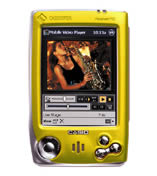Casio EM-500BU/GN/RD/SB/YW Pocket PC
Casio Updated: 2007-09-03The new slim designed EM-500BU is a mobile multimedia tool that targets a younger market. Designed to highlight Casio's new faster processor and available in 5 different colors, the EM-500 is stylishly designed and engineered to take advantage of the new and emerging digital content that is available on the Internet. (For on-line browsing and E-mail, an optional modem is required and sold separately.) The EM-500 is the first Pocket PC to feature the new MMC (multimedia card memory system) featuring postage stamp size memory cards with up to 64MB of storage. For Windows 95 without USB and Win NT option Serial Cable or USB Serial Cradle required.
EM-500 Technical Specifications
CPU: : NEC VR4122 (150MHz)
OS: : Microsoft® Windows® for Pocket PC 3.0
Memory: ROM: 16MB
RAM: 16MB
Display: LCD: 240x320 dots, Hyper Amorphous Silicon TFT color liquid crystal, 65,536-color, touch-panel display
Interfaces: Serial Port: RS-232C
USB: (Client)
Card Slot: MMC Card
Infrared: IrDA 1.2, communications distance: within 20cm; communications speed: 115.2 kbps maximum
Sound: Input: Internal microphone (mono)
Output: Internal speaker (mono), headphone jack (stereo)
Power Source: Main Battery: Special Lithium-Ion Rechargeable Battery (charge time: approximately 4.5 hours)/included AC adapter
Backup Battery: CR2032x1
Battery Life: Main Battery: Approximately 7 hours (when repeatedly operated 1 min. and displayed 10 min.)
Backup Battery: Approximately 5 years (when main battery is recharged soon after charge warning message)
Operating Temperature: : 0-40°C
Size and Weight: : 81.8 (W) x 128 (L) x 18.9 (H) mm/approximately 218g (including battery)
This product supports MultiMediaCards only. Though the User’s Guide and other user documentation and files say that CompactFlash cards are supported, this product does not support CompactFlash type Ethernet LAN cards, modem cards, etc.
Also note that specifications, peripherals, and other items can change suddenly to meet market needs. Such changes can cause user documentation contents to become inaccurate.
Tech Specs Subject to Change
Compatibility of future products with past or current products can not be assured.
Hardware(PDF:593KB)
Users Guide (PDF:853KB)
Mobile Calendar(PDF:251KB)
Mobile Address Book(PDF:127KB)
Mobile E-mailer(PDF:497KB)
Mail Setup Tool(PDF:42KB)
Mail Setup Manager for CASSIOPEIA(PDF:42KB)
Menu(PDF:89KB)
Card Backup Tool(PDF:52KB)
bTask™(PDF:45KB)
CSI Mobile Video Converter(PDF:115KB)
Mobile Picture & Video Player(PDF:826KB)
ZIO Golf(PDF:6.688KB)
Related Manuals
Casio PV-100 Pocket PC
Casio E-200 Pocket PC
Casio PV-200 Pocket PC
Casio E-15 Pocket PC
Casio PV-200A Pocket PC
Casio E-125 Pocket PC
Casio PV-400A Pocket PC
Casio E-115 Pocket PC
Casio E-11 Pocket PC
Casio PV-400Plus Pocket PC
Casio E-105 Pocket PC
Casio PV-S250 Pocket PC
